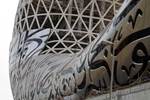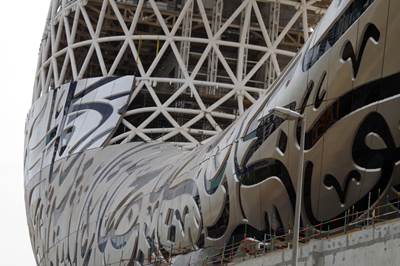MAE Museum dedicated to and built largely from new and recycled carbon fiber
Museum showcases the advancements in carbon fiber development where visitors can observe transformation process of acrylic fiber into carbon fiber.

MAE Museum, designed by Carlo Ratti Associatti (CRA) and architect Italo Rota for equipment manufacturer MAE. Renderings by CRA graphic team: Gary di Silvio, Pasquale Milieri, Gianluca Zimbardi.
“From high-performance bikes to the Lamborghini Aventador car, carbon fiber is driving innovation in multiple sectors. The MAE museum celebrates a defining material of modernity, by focusing on its new circular frontier and envisioning new applications for its use,” says Carlo Ratti, founding partner at CRA and a professor at the Massachusetts Institute of Technology (MIT, Cambridge, Mass., U.S.). “We are delighted to work with MAE, a company whose history and know-how pioneered the transition from the original use of acrylic fiber in clothing to today’s use of carbon fiber in industries as varied as aerospace and automotive.”
International design and innovation office CRA-Carlo Ratti Associati and architect Italo Rota have unveiled the design of the MAE Museum, an exhibition space dedicated to carbon fiber, a material that is central to the future of manufacturing. The museum itself will be built largely out of carbon fiber, both new and recycled, pursuing a circular approach to design. The exhibition path will employ robotics to guide visitors through what is said to be the world’s largest archive of acrylic fiber technologies, documenting scientific advancements in the development of carbon fiber, as well as parallel changes in society and fashion. Developed for leading polymer and fiber machinery manufacturing company MAE (Fiorenzuola d’Arda, Italy), the new museum will be located near the company’s headquarters, south of Piacenza, Italy.
Carbon fiber is a lightweight, high-strength material used in everything from aerospace to the automotive industry to bicycle manufacturing. It is manufactured using a type of acrylic fiber, similar to the one commonly used in clothing, which is transformed into carbon fiber through a complex chemical process made possible by the machines produced by MAE.
Similarly, the MAE museum’s exhibition path is conceived as a twofold journey from the past into the future, from the heyday of synthetic fibers in postwar European clothing, to the latest breakthroughs in chemical and engineering research. While the museum is located inside a renovated warehouse, most interior components are built with acrylic and carbon fiber, including the entrance doors which open like a curtain.

Renderings by Carlo Ratti Associatti (CRA).
In the first section of the museum, visitors will encounter a robotic archive warehouse, lit with dazzling white light and filled with MAE’s historical documents. A series of mechanical arms will move along the walls to extract photos, technical dossiers and campaigns from the brand’s 50-year history, and bring these items to a raised central platform, where visitors can sit and browse through them. After that, visitors will go through a long corridor where they can observe the process by which acrylic fiber is transformed into carbon fiber. This will be followed by the second section of the museum dedicated to the use of carbon fiber in contemporary industry. Within a black room enriched by an immersive installation, a set of interactive artifacts will explore the experimental applications of carbon fiber and show the most innovative prototypes made with it by leading companies in automotive and aerospace, for example.
The MAE Museum will be located at MAE’s Italian headquarters, just south of Piacenza and a one-hour drive from Milan. It will cater to different audiences including the general public and schools, as well as chemistry and engineering specialists. In early July 2021, MAE announced a collaboration with Leonardo (Rome, Italy), one of the world’s largest defense contractors, to build a €17-million pilot plant at this same location, which will produce innovative materials for use in the fields of aerospace, defense and security.
The MAE Museum project builds on recent CRA research in both the design of cultural spaces and the concept of circularity in architecture. The Italian Pavilion at Expo Dubai 2020, designed by CRA and Italo Rota along with F&M Ingegneria and Matteo Gatto, focuses specifically on the use of experimental construction materials, and will open in early October 2021. CRA also recently completed the construction of the MEET Digital Arts Center in Milan and curated the “Eyes of the City” exhibition at the eighth Bi-City Biennale of Urbanism and Architecture in Shenzhen, China.
Related Content
The lessons behind OceanGate
Carbon fiber composites faced much criticism in the wake of the OceanGate submersible accident. CW’s publisher Jeff Sloan explains that it’s not that simple.
Read MoreThe potential for thermoplastic composite nacelles
Collins Aerospace draws on global team, decades of experience to demonstrate large, curved AFP and welded structures for the next generation of aircraft.
Read MorePlant tour: Teijin Carbon America Inc., Greenwood, S.C., U.S.
In 2018, Teijin broke ground on a facility that is reportedly the largest capacity carbon fiber line currently in existence. The line has been fully functional for nearly two years and has plenty of room for expansion.
Read MorePlant tour: Albany Engineered Composites, Rochester, N.H., U.S.
Efficient, high-quality, well-controlled composites manufacturing at volume is the mantra for this 3D weaving specialist.
Read MoreRead Next
Building the Museum of the Future
FR composite panels provide structure, sealing and iconic facade for pioneering architecture in Dubai.
Read MoreVIDEO: High-volume processing for fiberglass components
Cannon Ergos, a company specializing in high-ton presses and equipment for composites fabrication and plastics processing, displayed automotive and industrial components at CAMX 2024.
Read MoreAll-recycled, needle-punched nonwoven CFRP slashes carbon footprint of Formula 2 seat
Dallara and Tenowo collaborate to produce a race-ready Formula 2 seat using recycled carbon fiber, reducing CO2 emissions by 97.5% compared to virgin materials.
Read More

























